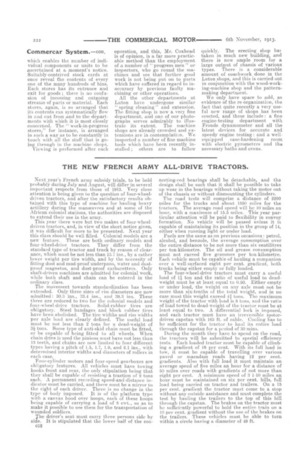THE NEW FRENCH ARMY ALL-DRIVE TRACTORS.
Page 14

If you've noticed an error in this article please click here to report it so we can fix it.
Next year's French army subsidy trials, to be held probably during July and August, will differ in several important respects from those of 1913. Very close attention is being given to the question of four-wheeldriven tractors, and after the satisfactory results obtained with this type of machine for hauling heavy artillery during the matnetivres and at some of the African colonial stations, the authorities are disposed to extend their use in the army.
This year there were but two makes of four-wheeldriven tractors, and, in view of the short notice given, it was difficult for more to be presented. Next year this class should be well filled. Colonial models are a new feature. These are both ordinary models and four-wheel-drive tractors. They differ from the standard type of tractor and truck by reason of clearance, which must be not less than 13.7 ins., by a rather lower weight per tire width, and by the necessity of fitting dust and mud-proof underpans, water and dustproof magnetos, and dust-proof carburetters. Only shaft-driven machines are admitted for colonial work, while both shaft and chain can be entered in the ordinary class.
The movement towards standardization has been extended. Only three sizes of rim diameters are now admitted : 30.3 ins., 33.4 ins. and 39.3 Ms. These three are reduced to two for the colonial models and four-wheel-drive tractors. Solid-rubber tires are obligatory. Steel bandages and block rubber tires have been abolished. The tire widths and rim widths per axle load are clearly defined. The useful load must be not less than 2 tons for a dead-weight of 31tons. Some type of anti-skid chain must be fitted, or be capable of being fitted to all wheels. When chain drive is used the pinions must have not less than 13 teeth, and chains are now limited to four different types having a pitch of 1.5, 1.7 1.9, and 2.1 ins. with determined interior widths and diameters of rollers in each case.
Four-cylinder motors and four-speed gearboxes are obligatory features. All vehicles must have towing books front and rear, the only stipulation being that they shall be capable of resisting a traction of 2 tons each. A permanent recording speed-and-distance indicator must be carried, and there must be a mirror to the right of each driver. There is no change in the type of body imposed. It is of the platform typo with a canvas hood over hoops, each of these hoops being capable of carrying a load of 8 cwt., so as to make it possible to use them for the transportation of wounded soldiers.
The driver's seat must carry three persons side by side. It is stipulated that the lower half of the con012
necting-rod bearings shall he detachable, and tho design shall be such that it shall be possible to take up wear in the bearings without taking the motor out of the chassis or without dismounting the cylinders.
The road tests will comprise a distance of 2200 miles for the trucks and about 1550 miles for the tractors. The average road speed will be 10 Miles an hour, with a maxinnim of 15.5 miles. This year particular attention will be paid to flexibility in convoy formation. No vehicle will be passed unless it is capable of maintaining its position in the group of 14, either when running light or under load.
Fuels are the same as on previous occasions : petrol, alcohol, and benzole, the average consumption over the entire distance to be not more than six centilitres per ton-kilometre. The oil and grease consumption must not exceed five grammes per tan-kilometre. Each vehicle must be capable of hauling a companion over a well-surfaced eight per cent. gradient, both trucks being either empty or fully loaded.
The four-wheel-drive tractors must carry a useful load of 1 ton and the ratio of useful load to deadweight must be at least equal to 0.50. Either empty or under load, the weight on any axle must not be more than six-tenths of the total weight, and in no case must this weight exceed 41 tons. The maximum weight of the tractor with load is 8 tons, and the ratio of load towed to dead-weight of the tractor must be at least equal to two. A differential lock is imposed, and each tractor must have an irreversible motordriven capstan with 165 ft. of cable. Cooling has to be sufficient for the tractor to haul its entire load through the capstan for a period of 30 mins.
During the month they have to spend on the road, the tractors will be submitted to special efficiency tests. Each loaded tractor must be capable of climbing a gradient of 18 per cent. With its full load in tow, it must be capable of travelling over various paved or macadam roads having 12 per cent, gradients. Also with full load it must maintain an average speed of five miles an hour for a distance of 50 miles over roads with gradients of not more than eight per cent. A minimum speed of 3 1-10 miles an hour must be maintained on six per cent, hills, full load being carried on tractor and trailers. On a 15 per cent, gradient the tractor must come to a stop without any outside assistance and must complete the test by hauling the trailers to the top of this hill through the capstan. The brakes on the tractor must be sufficiently powerful to hold the entire train on a 10 per cent. gradient without the use of the brakes on the trailers. These vehicles must be able to turn within a circle having a diameter of 49 ft.
























